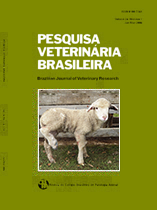 |
|
|
|
Year 2016 - Volume 36, Number 10
|

|
Osteology of Melanosuchus niger (Crocodylia: Alligatoridae) and the evolutionary evidence, 36(10):1025-1044
|
ABSTRACT.- Vieira L.G., Santos A.L.Q., Lima F.C., Mendonça S.H.S.T., Menezes L.T. & Sebben A. 2016. [Osteology of Melanosuchus niger (Crocodylia: Alligatoridae) and the evolutionary evidence.] Osteologia de Melanosuchus niger (Crocodylia: Alligatoridae) e a evidência evolutiva. Pesquisa Veterinária Brasileira 36(10):1025-1044. Laboratório de Ensino e Pesquisa em Animais Silvestres, Universidade Federal de Uberlândia, Rua Piauí s/n, Umuarama, Uberlândia, MG 38400-902, Brazil. E-mail: luceliabio@yahoo.com.br
The objective was an anatomical description of the skeleton of Melanosuchus niger, in order to contribute with evolutionary information about the species. Three adult specimens of M. niger with an average length of 2.40m were used, originating from the biologic collection of Lapas-UFU. In the forelimb, the scapula is bigger than the coracoid. Regarding the hindlimbs, the pubic does not participate in the formation of the acetabulum; the contact with the ilium is made by ligaments, and its articulation with the rump allows dorsal-ventral movements. Regarding the forelimbs, the humerus is a stylopodium element, and the ulna and radius a zeugopodium element. The carpus exibits the ulnar-radial+intermedium fusion, fusion of the distal carpals 3+4+5, and the pisiform. It has five metacarpals, numbered lateromedially as metacarpal 1, 2, 3, 4, and 5. The phalangeal formula is 2:3:4:3:2. Regarding the pelvic limbs, the stylopodium is formed by the femur, and the zeugopodium by tibia and fibula. In tarsus has four bones: fusion of the intermedium+centrale, fibulare, distal tarsal 3, and distal tarsal 4. It has four long metatarsals I, II, III and IV, with metatarsal II and III being relatively longer than the others. Metatarsal V is a very small bone; the feet have the phalangeal formula 2:3:4:4. At the skull, the nasal opening is only the palatine bones, vomer, pterygoid, premaxilla and maxilla forming the bone structure of the secondary palate; the parietal bone is the only element on the cranial roof. In the pos- axial skeleton ist distinct pairs of ribs which articulate with the cervical, dorsal, lumbar, sacral and caudal vertebrae. The gastralia consists of seven rows of fine bone located between the pubic bone and caudal part of the sternum. |
| |
|
|
| |
|
 |